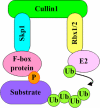Recent advances in SCF ubiquitin ligase complex: Clinical implications
- PMID: 27156687
- PMCID: PMC4980229
- DOI: 10.1016/j.bbcan.2016.05.001
Recent advances in SCF ubiquitin ligase complex: Clinical implications
Abstract
F-box proteins, which are subunit recruiting modules of SCF (SKP1-Cullin 1-F-box protein) E3 ligase complexes, play critical roles in the development and progression of human malignancies through governing multiple cellular processes including cell proliferation, apoptosis, invasion and metastasis. Moreover, there are emerging studies that lead to the development of F-box proteins inhibitors with promising therapeutic potential. In this article, we describe how F-box proteins including but not restricted to well-established Fbw7, Skp2 and β-TRCP, are involved in tumorigenesis. However, in-depth investigation is required to further explore the mechanism and the physiological contribution of undetermined F-box proteins in carcinogenesis. Lastly, we suggest that targeting F-box proteins could possibly open new avenues for the treatment and prevention of human cancers.
Keywords: F-box protein; Human cancer; Oncoprotein; Tumor suppressor; Ubiquitin.
Copyright © 2016 Elsevier B.V. All rights reserved.
Figures
Similar articles
-
The characteristics and roles of β-TrCP1/2 in carcinogenesis.FEBS J. 2021 Jun;288(11):3351-3374. doi: 10.1111/febs.15585. Epub 2020 Oct 23. FEBS J. 2021. PMID: 33021036 Review.
-
Inhibition of SCF ubiquitin ligases by engineered ubiquitin variants that target the Cul1 binding site on the Skp1-F-box interface.Proc Natl Acad Sci U S A. 2016 Mar 29;113(13):3527-32. doi: 10.1073/pnas.1519389113. Epub 2016 Mar 14. Proc Natl Acad Sci U S A. 2016. PMID: 26976582 Free PMC article.
-
Prognostic values of F-box members in breast cancer: an online database analysis and literature review.Biosci Rep. 2019 Jan 3;39(1):BSR20180949. doi: 10.1042/BSR20180949. Print 2019 Jan 31. Biosci Rep. 2019. PMID: 30341246 Free PMC article. Review.
-
Thiazolidinediones modulate the expression of beta-catenin and other cell-cycle regulatory proteins by targeting the F-box proteins of Skp1-Cul1-F-box protein E3 ubiquitin ligase independently of peroxisome proliferator-activated receptor gamma.Mol Pharmacol. 2007 Sep;72(3):725-33. doi: 10.1124/mol.107.035287. Epub 2007 Jun 14. Mol Pharmacol. 2007. PMID: 17569795
-
Genetically engineered mouse models for functional studies of SKP1-CUL1-F-box-protein (SCF) E3 ubiquitin ligases.Cell Res. 2013 May;23(5):599-619. doi: 10.1038/cr.2013.44. Epub 2013 Mar 26. Cell Res. 2013. PMID: 23528706 Free PMC article. Review.
Cited by
-
ASB7 regulates spindle dynamics and genome integrity by targeting DDA3 for proteasomal degradation.J Cell Biol. 2016 Oct 10;215(1):95-106. doi: 10.1083/jcb.201603062. Epub 2016 Oct 3. J Cell Biol. 2016. PMID: 27697924 Free PMC article.
-
CSNAP, the smallest CSN subunit, modulates proteostasis through cullin-RING ubiquitin ligases.Cell Death Differ. 2020 Mar;27(3):984-998. doi: 10.1038/s41418-019-0392-8. Epub 2019 Jul 31. Cell Death Differ. 2020. PMID: 31367012 Free PMC article.
-
FBXW7 in Cancer: What Has Been Unraveled Thus Far?Cancers (Basel). 2019 Feb 19;11(2):246. doi: 10.3390/cancers11020246. Cancers (Basel). 2019. PMID: 30791487 Free PMC article. Review.
-
The critical role of BTRC in hepatic steatosis as an ATGL E3 ligase.J Mol Cell Biol. 2024 Apr 4;15(10):mjad064. doi: 10.1093/jmcb/mjad064. J Mol Cell Biol. 2024. PMID: 37873692 Free PMC article.
-
FBXL4 deficiency increases mitochondrial removal by autophagy.EMBO Mol Med. 2020 Jul 7;12(7):e11659. doi: 10.15252/emmm.201911659. Epub 2020 Jun 11. EMBO Mol Med. 2020. PMID: 32525278 Free PMC article.
References
-
- Nalepa G, Rolfe M, Harper JW. Drug discovery in the ubiquitin-proteasome system. Nature reviews. Drug discovery. 2006;5:596–613. - PubMed
Publication types
MeSH terms
Substances
Grants and funding
LinkOut - more resources
Full Text Sources
Other Literature Sources
Miscellaneous



